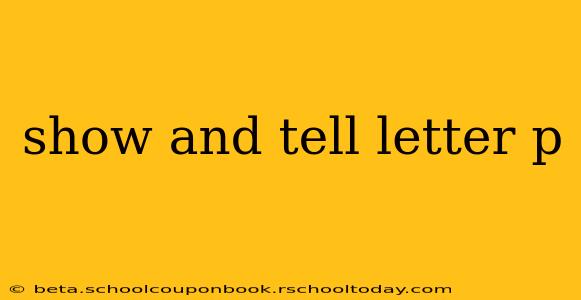Learning the alphabet is a cornerstone of early childhood development, and each letter offers a unique opportunity for fun and educational activities. This guide focuses on the letter P, providing engaging ideas for a "show and tell" presentation, suitable for preschoolers, kindergartners, and even early elementary school students. We'll cover various aspects of the letter P, incorporating visual aids, interactive elements, and hands-on experiences to make learning memorable and enjoyable.
What Does the Letter P Look Like?
The letter P is formed with a curve and a vertical line. It's a bit like a backwards C with a leg! We can show this visually using different methods:
- Visual Aids: Display flashcards showing uppercase P (P) and lowercase p (p). Consider using colorful, engaging flashcards with pictures of objects starting with P.
- Drawing: Draw a large P on a whiteboard or chart paper, then trace over it with different colors, textures (like glitter glue!), or even different materials (like yarn).
- Tactile Learning: Create a P shape using playdough, pipe cleaners, or even building blocks. This helps children physically engage with the letter's form.
What are some words that start with P?
This is a great opportunity to introduce a range of vocabulary and reinforce letter recognition. Use pictures and real objects whenever possible to enhance understanding. Here are a few examples:
- Penguin: Show a picture of a penguin or even a toy penguin.
- Pineapple: If possible, bring a real pineapple; its unique appearance will engage children.
- Puppy: Pictures of adorable puppies are always a hit.
- Pen: Show a pen and let the children try to write with it (under supervision, of course).
- Pig: Show a picture or a toy pig.
What Sounds Does the Letter P Make?
The letter P makes a "puh" sound. This is an important distinction to make early on. Help your child hear the difference between sounds.
- Sound Games: Play sound games to differentiate “P” sounds from other similar sounds (like “B”). Use words like “pen” and “ben”, having children say them aloud and notice the difference in pronunciation.
- Repeated practice: Repeatedly pronounce words starting with "P," encouraging children to repeat after you.
How Many Things Can You Find That Start With P?
This is an interactive game that fosters observational skills and reinforces letter recognition. Before the show-and-tell, you can encourage the child to find as many objects as possible around their home that start with P. This could include pictures in books, toys, or even items in their room.
- Interactive Show and Tell: During the presentation, allow the child to show their collection and explain each item.
People Also Ask: Frequently Asked Questions about the Letter P
Here are some common questions parents and educators ask about teaching the letter P:
How can I make learning the letter P fun for my child?
Learning the letter P can be fun through engaging activities. Interactive games, crafts, songs, and stories that include words beginning with P can help maintain interest and focus. Making the learning experience hands-on and multi-sensory increases its effectiveness.
What are some good books about the letter P?
Many children's books feature the letter P prominently. Look for books with simple texts, repetitive phrases, and colorful illustrations. A quick search online for "children's books letter P" will provide a wide selection.
What are some simple crafts I can do with my child to reinforce learning the letter P?
Simple crafts are excellent ways to consolidate knowledge. Create a P-shaped collage using various materials, paint a P, or use playdough to mold the letter's shape. The tactile experience solidifies learning.
Conclusion
Learning the letter P doesn’t have to be a chore; it can be an exciting journey of discovery! By utilizing various teaching methods—visual aids, interactive games, and creative activities—children can develop a strong understanding of this crucial letter and its many associated words. Remember to make it fun, engaging, and personalized to your child's learning style.
